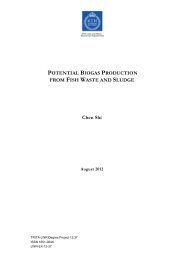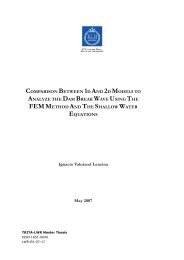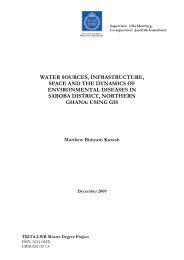radon in groundwater - Mark- och vattenteknik - KTH
radon in groundwater - Mark- och vattenteknik - KTH
radon in groundwater - Mark- och vattenteknik - KTH
- No tags were found...
Create successful ePaper yourself
Turn your PDF publications into a flip-book with our unique Google optimized e-Paper software.
Radon <strong>in</strong> <strong>groundwater</strong> - Influenc<strong>in</strong>g factors and prediction methodology for a Swedish environmentRESULTS AND DISCUSSIONSThe 4439 private drilled wells analysed <strong>in</strong>this study were found to be irregularly distributed<strong>in</strong> Stockholm County, with relativelyfew wells <strong>in</strong> the middle and southernparts of the county as shown <strong>in</strong> Fig. 1. Ananalysis of the data revealed that for themajority of the wells (73%), 222 Rn concentrationsvaried between 0 and 500 Bq/l and11% of all wells exceeded 1000 Bq/l, theSwedish regulatory limit for <strong>radon</strong> concentration<strong>in</strong> dr<strong>in</strong>k<strong>in</strong>g water. The maximumconcentration recorded was 63 560 Bq/lwhile the m<strong>in</strong>imum was 4 Bq/l. Two otherwells also had very high <strong>radon</strong> concentrations<strong>in</strong> the order of 14 000 Bq/l and 15 000Bq/l. The geometrical mean was found to be230 Bq/l and a standard deviation of 1227Bq/l was computed. The distribution of<strong>radon</strong> values, viewed on a histogram, waspositively skewed and removal of outlierswas necessary (except for visual data m<strong>in</strong><strong>in</strong>g)to avoid bias <strong>in</strong> statistical analyses. Outlierswere case-specifically def<strong>in</strong>ed as <strong>radon</strong> concentrationsexceed<strong>in</strong>g 5000 Bq/l and removed.The traditional def<strong>in</strong>ition of outliers<strong>in</strong> the one-dimensional case that a po<strong>in</strong>t isan outlier if its distance from the mean isgreater than some factor times the standarddeviation (usually ± 2 standard deviations)was not considered, s<strong>in</strong>ce its application didnot improve the skewedness of the dataset.Radon concentration values exceed<strong>in</strong>g 5000Bq/l were observed <strong>in</strong> 21 wells, constitut<strong>in</strong>gless than 0.5% of total available wells. High<strong>radon</strong> concentrations can be encountered <strong>in</strong>wells drilled from granite rocks with anenriched content of uranium deposited onthe <strong>in</strong>ner surfaces of fractures.Visual data m<strong>in</strong><strong>in</strong>gThe visual analysis of 3D images was appropriatefor the problem s<strong>in</strong>ce all of the variables<strong>in</strong>vestigated could either be convertedto surface maps or visualised <strong>in</strong> GIS. It waspossible to detect visually whether a relationshipexisted between a thematic map andthe <strong>radon</strong> concentration <strong>in</strong> <strong>groundwater</strong>. Asmentioned <strong>in</strong> the methodology section, a<strong>radon</strong> surface needed to be built from po<strong>in</strong>tdata prior to visualisation. In the project,<strong>radon</strong> measurements were not sufficient tobuild a representative surface over the wholearea. Interpolation of all po<strong>in</strong>t data to produceone surface was found to produce lotsof ‘U’ effects (sharp edges) around extremevalues and this was <strong>in</strong>evitable because visualdata m<strong>in</strong><strong>in</strong>g <strong>in</strong>volves analysis of all data,without the removal of outliers. Therefore,only a small sample of the study with anacceptable distribution of wells was subjectedto <strong>in</strong>vestigation.In the various visualisations, the follow<strong>in</strong>gwere observed:1) High <strong>radon</strong> values occurred predom<strong>in</strong>antlyon low elevations and vice versa2) Areas overla<strong>in</strong> with till or clay had high<strong>radon</strong> concentrations <strong>in</strong> the bedrock<strong>groundwater</strong>3) Peaks of high <strong>radon</strong> concentrations werenot always located <strong>in</strong> regions where highuranium content <strong>in</strong> bedrock had been recorded<strong>in</strong> airborne measurements.4) Radon concentrations from steep terra<strong>in</strong>were generally not high but no clear-cutconclusions could be drawn from the thematicmap of relative altitude5) Granitic rocks were associated with high<strong>radon</strong> values6) The shorter the distance between a fracturezone and the bedrock well, the higherthe concentration of <strong>radon</strong> <strong>in</strong> <strong>groundwater</strong>.A multi-dimensional visualisation (Fig. 3)<strong>in</strong>volv<strong>in</strong>g five different variables was an<strong>in</strong>terest<strong>in</strong>g example of how the effects ofpeaks and depressions <strong>in</strong> a surface comb<strong>in</strong>edwith colour effects allowed the observer toget <strong>in</strong>sight <strong>in</strong>to the data, draw conclusionsand directly <strong>in</strong>teract with the data. In thatvisualisation, the two-dimensional geographicalextent and the <strong>radon</strong> concentrationsconstitute three spatial dimensions.The bedrock surface draped over the <strong>radon</strong>surface is the fourth variable and f<strong>in</strong>ally thefracture l<strong>in</strong>es constitute a fifth variable andare draped over the last surface produced.11
















